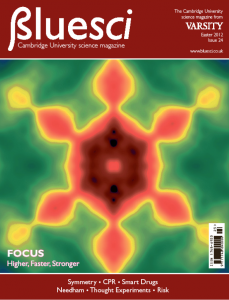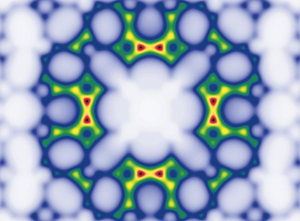FRIDAY, 27 APRIL 2012
The magnetic properties of materials can be thought of as arising from microscopic bar magnets located on each atom of the material. At high temperatures, these magnets are arranged randomly, like atoms or molecules in a gas. By contrast, at low temperatures the magnets usually order themselves, analogous to the atoms in a crystal. The way these magnets align depends on the atomic structure of the material, and determines its magnetic properties.The arrangement of atoms in a material can be probed by using a technique known as neutron scattering, whereby a sample is bombarded with a beam of neutrons. When the beam comes into contact with the regular atomic structure of a crystalline sample it is scattered, and the resulting pattern can be analysed to deduce the original structure of the material. This allows us to describe structures that, even with the best microscopes available, are too small to observe directly. Since neutrons are uncharged, they are able to penetrate matter farther than charged particles, so are sensitive to the bulk structure of the material, not just the surface. They also probe the atomic nuclei rather than the surrounding electrons and interact directly with the magnetic fields in the sample, so that measurements of the magnetic structure can be obtained along with the atomic arrangement.
Although most magnetic materials behave in the way described above—showing magnetic order at sufficiently low temperatures—there are a small number which do not. In these ‘frustrated magnets’, the geometry of the crystal structure can prevent a regular pattern from occurring. Take a simple triangle as an example: if magnets are placed at each corner and two point in opposite directions, there is no direction that the third can face in order to oppose both of the others. The frustration of these magnetic moments can lead to some interesting properties. For example, spin ice, a form of frustrated magnet, has been found to behave like a gas of magnetic monopoles—hypothetical magnetic north poles without opposing south poles. Limited evidence has also shown that some frustrated magnets may act as high-temperature superconductors, which are much sought after for their potential to enable electric power transmission with greatly reduced energy loss. Unlike the sharp peaks seen for most magnets, neutron scattering experiments performed on a large single crystal of a frustrated magnet would result in patterns resembling that of our cover image, which still shows structure and symmetry but is quite diffuse.
However, the cover image for this issue was not actually obtained through a single crystal experiment. Instead, this image was produced, by Joseph Paddison and Andrew Goodwin of Oxford University, from powder scattering data using a computer modelling technique. In neutron scattering experiments using powder samples, the small crystallites that make up the sample are randomly oriented, and measurements take an average over all of these orientations. This means that the diffraction pattern is not an intricate two-dimensional image but is collapsed into a simple graph of intensities. Paddison and Goodwin simulated such powder data for some systems where the magnetic structures were already well understood. They were then able to find a structural model that best fit the data. This allowed the single crystal image to be reconstructed, in strong agreement to experimental data actually collected from crystals.
The cover image is a proof-of-principle example of a reconstructed neutron diffraction pattern based only on data from powder neutron diffraction. Since many materials cannot be successfully crystallised, this approach offers many new possibilities for the study of frustrated magnets.
Lindsey Nield is a 3rd year PhD student in the Department of Physics


